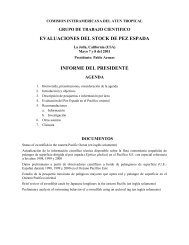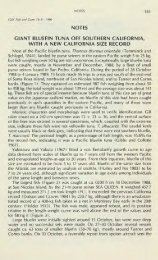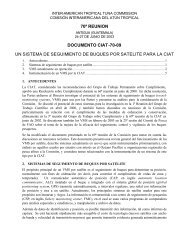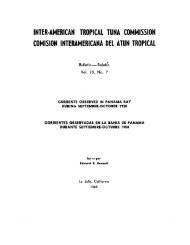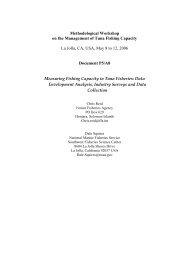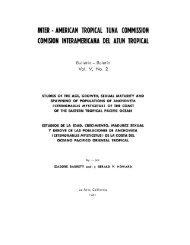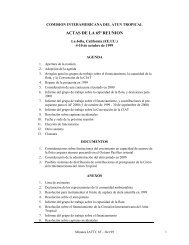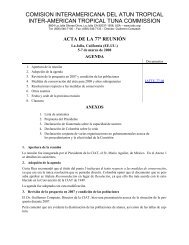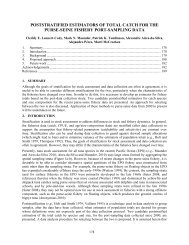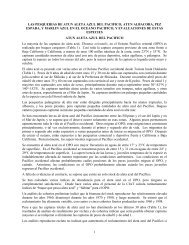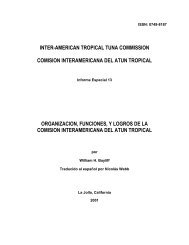Informe Anual de la Comisión Interamericana del Atún Tropical, 19
Informe Anual de la Comisión Interamericana del Atún Tropical, 19
Informe Anual de la Comisión Interamericana del Atún Tropical, 19
You also want an ePaper? Increase the reach of your titles
YUMPU automatically turns print PDFs into web optimized ePapers that Google loves.
ANNUAL REPORT <strong>19</strong>87<br />
Panamanian fisheries personnel. The presence ofCommission scientists at this <strong>la</strong>boratory has ma<strong>de</strong><br />
it possible to provi<strong>de</strong> assistance to local scientists in the implementation of research projects on<br />
species other than tunas, e.g. snappers. Consi<strong>de</strong>rable progress has been ma<strong>de</strong> in the snapper<br />
program; this subject is discussed in the section entitled Achotines <strong>la</strong>boratory.<br />
FIELD STATIONS<br />
The Commission maintains field offices in San Pedro, California, Manta, Ecuador, Ensenada,<br />
Mexico, Panama, Republic of Panama, Coishco, Peru, Mayaguez, Puerto Rico, and Cumaná,<br />
Venezue<strong>la</strong>. The scientists and technicians stationed at these offices col1ect <strong>la</strong>ndings statistics,<br />
abstract the logbooks of tuna vessels to get catch and effort data, measure fish and col1ect other<br />
biological data, and assist with the training and p<strong>la</strong>cement of scientific technicians aboard vessels<br />
participating in the Commission's tuna-dolphin programo This work is carried out not only in the<br />
above-named ports, but also in other ports in Colombia, Costa Rica, Ecuador, Mexico, Panama, Peru,<br />
Puerto Rico, and Venezue<strong>la</strong>, which are visited periodically by these employees. Not all of these tasks<br />
are performed by Commission employees in all the above-named countries, however; for example, in<br />
<strong>19</strong>87 they participated in the tuna-dolphin work only in Ecuador, Mexico, Panama, and Venezue<strong>la</strong>.<br />
In addition, the Commission maintains a<strong>la</strong>boratory at Achotines Bay,just west ofPunta Ma<strong>la</strong><br />
on the Azuero Peninsu<strong>la</strong> of Panama. The Achotines <strong>la</strong>boratory is used principal1y for studies of the<br />
early life history oftunas. Such studies are ofgreat importance, as acquisition ofknowledge ofthe life<br />
history oftunas prior to recruitment into the fishery would eliminate much ofthe uncertainty which<br />
currently exists in the staffs assessments of the condition of the various stocks of tunas. The<br />
Commission p<strong>la</strong>ns to en<strong>la</strong>rge the <strong>la</strong>boratory facilities so that there will be a<strong>de</strong>quate space for<br />
investigators from other agencies, such as Panama's Dirección General <strong>de</strong> Recursos Marinos, the<br />
University of Panama, etc.<br />
PUBLICATIONS AND REPORTS<br />
The prompt and complete publication of research results is one of the most important<br />
elements of the Commission's program of scientific investigations. By this means the member<br />
governments, the scientific community, and the public at <strong>la</strong>rge are currently informed of the<br />
research findings of the IATTC staff. The publication of basic data, methods of analysis, and<br />
conclusions afford the opportunity for critical review by other scientists, ensuring the soundness of<br />
the conclusions reached by the IATTC staff, as well as enlisting the interest of other scientists in the<br />
Commission's research. By the end of<strong>19</strong>87 the IATTC staffhad published 125 Bulletins, 36 Annual<br />
Reports,5 Special Reports, 5books, and 309 chapters and articles in books and outsi<strong>de</strong> journals. The<br />
publications by staffmembers received during <strong>19</strong>87 are listed in Appendix 3 ofthis reporto<br />
THE FISHERY IN <strong>19</strong>87<br />
During past years catch quotas for yellowfin tuna, Thunnus albacares, for the Commission's<br />
Yellowfin Regu<strong>la</strong>tory Area (CYRA, Figure 1) have been recommen<strong>de</strong>d by the IATTC staff and<br />
variously adopted in Commission resolutions and implemented by the countries participating in the<br />
fishery. Quotas for <strong>19</strong>66 through <strong>19</strong>79 were adopted and implemented. At its 37th meeting, held in<br />
October <strong>19</strong>79, the Commission was unable to arrive at an agreement concerning a yel10wfin<br />
conservation program for <strong>19</strong>80; it subsequently agreed to a quota of 165,000 short tons, with<br />
provisions to increase it at the discretion ofthe Director, but the quota was not implemented. At the<br />
38th through 43nd meetings the IATTC staffrecommen<strong>de</strong>d quotas of160,000 tons for <strong>19</strong>81 and <strong>19</strong>82,<br />
11



